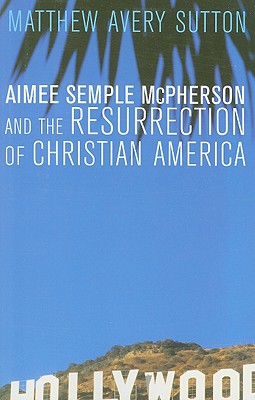Earlier this academic year, Pittsburgh Theological Seminary’s American Religious Biography class studied biographical accounts of seven women and men whose lives spanned the centuries from the colonial era through the 20th century. After digging deeply into the historical accounts of those Christian figures, students reflected on what insight each narrative might have for modern Christians, asking What we can learn from the past to inform modern lives of faith? The blog below is the second in a four-part series of reflections by students in this course taught by the Rev. Dr. Heather Vacek. Read the previous reflections—Redeemer: The Life of Jimmy Carter and Dream Is Freedom: Pauli Murray & American Democratic Faith.
Is there more to the “Preachers of L.A.” than their flamboyant proclamations of “prosperity theology,” lavish and controversial lifestyles? Modern viewers raise valid questions about this show. Their concerns are not isolated to our times, nor do they tell the whole story. Matthew Avery Sutton’s Aimee Semple McPherson and the Resurrection of Christian America presented the life of the first “preacher of L.A.” The early 20th century preacher, Sister Aimee, embodied the confluence of traditional church and culture norms with an innovative, transformative, and controversial ministry and lifestyle. Her story asks Christians, “are we brave enough to be the Christians we want to be, but probably will not let ourselves be, because of moral and cultural expectations?”As Aimee Semple McPherson’s ministry influenced countless people through her astonishing use and transcendence of American old-time religion, technology, drama, scandal, and patriotism, she proved that unorthodox methods could serve people in a way that traditional methods could not.
Sutton’s book showed “how Americans came to embrace a thoroughly modern form of evangelicalism that had its roots in McPherson’s innovations and concerns” (6). McPherson thought that Christians should affect culture. She also understood that culture affected Christians. She embodied the tensions of John 15:19 and 1 Corinthians 9:19-23 throughout her life. Her actions often outpaced ecclesial and secular expectations, due to God’s call on her life. Sutton explained, “God told Aimee. . . ‘even so have I chosen and ordained thee, that thou shouldst go forth, and clear away the debris and contamination, with which they have covered and obscured the light of My Word” (11). Sutton used this interplay of Sister Aimee’s calling and her response to traditional gender roles to frame her life journey.
McPherson’s interaction with American culture was marked by contradictions, controversy, and captivation. She stressed “old-time religion,” yet used innovative ways to convey her message. In Sister Aimee’s “Arrested for Speeding” sermon, she rode a motorcycle and “flipped on the motorcycle siren, letting it wail while the audience gasped. Nobody dozed off during that service focusing on individuals’ need for salvation” (72). McPherson also used radio and movies to resurrect revival Christianity. Sutton wrote, “McPherson repackaged the gospel of individual salvation for a new generation of men and women fascinated by radio, moving pictures, automobiles, and a host of new consumer goods” (278). The unusual transmission of this unorthodox messenger opened the Gospel to reach and affect more people than the ways deemed culturally acceptable.
As great as that ideal of the Gospel is, human personality does factor into its transmission. While McPherson initially intended to serve the middle-class, she got caught up in the world of cultural elites and celebrities. Sutton described how Sister Aimee would often portray herself as the “traditional Victorian middle-class white woman, to deflect criticism,” but she became embroiled in a kidnapping scandal rooted in rumors of sexual infidelity, and garnered criticism for the subtly erotic tones of her identification with the Bride of Christ (104). Positive and negative critiques of her body, fashion, and hair were based on popular ideas about the “conservative” or “new” woman. Yet, Sutton suggested that McPherson, “humanized Jesus, making him come to life as a real person who earnestly sought a relationship with every human being. . .[presenting] Christianity in simple, clear terms, in such a way as to make it almost impossible to reject” (20). Her captivating ministry attracted many believers from diverse backgrounds and races, including (bewilderingly) the Ku Klux Klan. While we are allowed to criticize such connections as possibly naive and racist, there might be a lesson to learn in witnessing the power of a radical Christian ministry serving every segment of society, beyond cultural preferences.
In her imperfect, yet astonishing way, Aimee Semple McPherson helps us to remember that Christianity involves the risk of being unorthodox in an orthodox society. Of course, we should not give unorthodoxy a free pass. However, if we surrender to dominant definitions of church, race, and gender roles, we deny God’s unpredictable and unexpected work through overlooked historical figures. And is this not what the Gospel is about—surprising and transforming people with God’s good news, beyond culture?
All Citations taken from: Sutton, Matthew Avery. Aimee Semple Mcpherson and the Resurrection of Christian America. Cambridge, Mass.: Harvard University Press, 2007.
The full reading list for the Fall 2015 American Religious Biography course included: Catherine Brekus, Sarah Osborn’s World: The Rise of Evangelical Christianity in Early America (2013), John Wigger, American Saint: Francis Asbury and the Methodists (2009), Jon Sensbach, Rebecca’s Revival: Creating Black Christianity in the Atlantic World (2005), Richard S. Newman, Freedom’s Prophet: Bishop Richard Allen, the AME Church, and the Black Founding Fathers (2008), Matthew Avery Sutton, Aimee Semple McPherson and the Resurrection of Christian America (2007), Sarah Azaransky, The Dream is Freedom: Pauli Murray and Democratic American Faith (2011), Randall Balmer, Redeemer: The Life of Jimmy Carter (2014). In addition, readers interested in the role of history in the life of faith might enjoy: Margaret Bendroth, The Spiritual Practice of Remembering (2013).
Gregory Jones Jr. is a junior master of arts student at Pittsburgh Theological Seminary.

